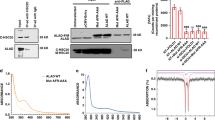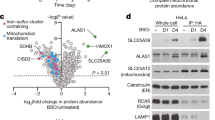Abstract
Iron is required to produce haem and iron–sulphur (Fe–S) clusters, processes thought to occur independently1,2. Here we show that the hypochromic anaemia in shiraz (sir) zebrafish mutants is caused by deficiency of glutaredoxin 5 (grx5), a gene required in yeast for Fe–S cluster assembly. We found that grx5 was expressed in erythroid cells of zebrafish and mice. Zebrafish grx5 rescued the assembly of Δgrx5 yeast Fe–S, showing that the biochemical function of grx5 is evolutionarily conserved. In contrast to yeast, vertebrates use iron regulatory protein 1 (IRP1) to sense intracellular iron and regulate mRNA stability or the translation of iron metabolism genes1,2. We found that loss of Fe–S cluster assembly in sir animals activated IRP1 and blocked haem biosynthesis catalysed by aminolaevulinate synthase 2 (ALAS2). Overexpression of ALAS2 RNA without the 5′ iron response element that binds IRP1 rescued sir embryos, whereas overexpression of ALAS2 including the iron response element did not. Further, antisense knockdown of IRP1 restored sir embryo haemoglobin synthesis. These findings uncover a connection between haem biosynthesis and Fe–S clusters, indicating that haemoglobin production in the differentiating red cell is regulated through Fe–S cluster assembly.
This is a preview of subscription content, access via your institution
Access options
Subscribe to this journal
Receive 51 print issues and online access
$199.00 per year
only $3.90 per issue
Buy this article
- Purchase on Springer Link
- Instant access to full article PDF
Prices may be subject to local taxes which are calculated during checkout




Similar content being viewed by others
References
Napier, I., Ponka, P. & Richardson, D. R. Iron trafficking in the mitochondrion: novel pathways revealed by disease. Blood 105, 1867–1874 (2005)
Hentze, M. W., Muckenthaler, M. U. & Andrews, N. C. Balancing acts: molecular control of mammalian iron metabolism. Cell 117, 285–297 (2004)
Fernandes, A. P. & Holmgren, A. Glutaredoxins: glutathione-dependent redox enzymes with functions far beyond a simple thioredoxin backup system. Antioxid. Redox. Sig. 6, 63–74 (2004)
Rodriguez-Manzaneque, M. T. et al. Grx5 is a mitochondrial glutaredoxin required for the activity of iron/sulfur enzymes. Mol. Biol. Cell 13, 1109–1121 (2002)
Mühlenhoff, U. et al. Components involved in assembly and dislocation of iron-sulfur clusters on the scaffold protein Isu1p. EMBO J. 22, 4815–4825 (2003)
Vilella, F. et al. Evolution and cellular function of monothiol glutaredoxins: involvement in iron-sulfur cluster assembly. Comp. Funct. Genom. 5, 328–341 (2004)
Alves, R., Herrero, E. & Sorribas, A. Predictive reconstruction of the mitochondrial iron-sulfur cluster assembly metabolism. II. Role of glutaredoxin 5. Proteins Struct. Funct. Bioinformatics 57, 481–492 (2004)
Belli, G. et al. Structure–function analysis of yeast Grx5 monothiol glutaredoxin defines essential amino acids for the function of the protein. J. Biol. Chem. 277, 37590–37596 (2002)
Tamarit, J. et al. Biochemical characterization of yeast mitochondrial Grx5 monothiol glutaredoxin. J. Biol. Chem. 278, 25745–25751 (2003)
Beinert, H., Holm, R. H. & Münck, E. Iron-sulfur clusters: nature's modular, multipurpose structures. Science 277, 653–659 (1997)
Rodriguez-Manzaneque, M. T. et al. Grx5 glutaredoxin plays a central role in protection against protein oxidative damage in Saccharomyces cerevisiae. Mol. Biol. Cell 19, 8180–8190 (1999)
Lill, R. & Kispal, G. Maturation of celluar Fe-S proteins: an essential function of mitochondria. Trends Biochem. Sci. 25, 352–356 (2000)
Mootha, V. K. et al. Integrated analysis of protein composition, tissue diversity, and gene regulation in mouse mitochondria. Cell 115, 629–640 (2003)
Land, T. & Rouault, T. A. Targeting of a human iron–sulfur cluster assembly enzyme, nifs, to different subcellular compartments is regulated through alternative AUG utilization. Mol. Cell 2, 807–815 (1998)
Tong, W. H. & Rouault, T. Distinct iron–sulfur cluster assembly complexes exist in the cytosol and mitochondria of human cells. EMBO J. 19, 5692–5700 (2000)
Brownlie, A. et al. Positional cloning of the zebrafish sauternes gene: a model for congenital sideroblastic anemia. Nature Genet. 20, 244–250 (1998)
Dernbach, E. et al. Antioxidative stress-associated genes in circulating progenitor cells: evidence for enhanced resistance against oxidative stress. Blood 104, 3591–3597 (2004)
Rouault, T. A. & Klausner, R. D. Iron-sulfur clusters as biosensors of oxidants and iron. Trends Biochem. Sci. 21, 174–177 (1996)
Nakajima, O. et al. Heme deficiency in erythroid lineage causes differentiation arrest and cytoplasmic iron overload. EMBO J. 18, 6282–6289 (1999)
Gross, U., Hoffmann, G. F. & Doss, M. O. Erythropoietic and hepatic porphyrias. J. Inherit. Metab. Dis. 23, 641–661 (2000)
Jaffrey, S. R., Haile, D. J., Klausner, R. D. & Harford, J. B. The interaction between the iron-responsive element binding protein and its cognate RNA is highly dependent upon both RNA sequence and structure. Nucleic Acids Res. 21, 4627–4631 (1993)
Henderson, B. R., Menotti, E. & Kühn, L. C. Iron regulatory proteins 1 and 2 bind distinct sets of RNA target sequences. J. Biol. Chem. 271, 4900–4908 (1996)
Allikmets, R. et al. Mutation of a putative mitochondrial iron transporter gene (ABC7) in X-linked sideroblastic anemia and ataxia (XLSA/A). Hum. Mol. Genet. 8, 743–749 (1999)
Bekri, S. et al. Human ABC7 transporter: gene structure and mutation causing X-linked sideroblastic anemia with ataxia with disruption of cytosolic iron-sulfur protein maturation. Blood 96, 3256–3264 (2000)
Maguire, A. et al. X-linked cerebellar ataxia and sideroblastic anemia associated with a missense mutation in the ABC7 gene predicting V411L. Br. J. Haematol. 115, 910–917 (2001)
Kispal, G., Csere, P., Prohl, C. & Lill, R. The mitochondrial proteins Atm1p and Nfs1p are essential for biogenesis of cytosolic Fe/S proteins. EMBO J. 18, 3981–3989 (1999)
Wingert, R. A. et al. The chianti zebrafish mutant provides a model for erythroid-specific disruption of transferrin receptor 1. Development 131, 6225–6235 (2004)
Ransom, D. G. et al. Characterization of zebrafish mutants with defects in embryonic hematopoiesis. Development 124, 311–319 (1996)
Palis, J. & Kingsley, P. D. Differential gene expression during early murine yolk sac development. Mol. Reprod. Dev. 42, 19–27 (1995)
Chen, O. S., Hemenway, S. & Kaplan, J. Genetic analysis of iron citrate toxicity in yeast: implications for mammalian iron homeostasis. Proc. Natl Acad. Sci. USA 99, 16922–16927 (2002)
Acknowledgements
We thank all members of the Zon laboratory for their advice and support. R.A.W. is a Harvard University Fellow of the Albert J. Ryan Foundation. L.I.Z. is an Investigator of the Howard Hughes Medical Institute. This work was supported by HHMI and NIH grants.
Author information
Authors and Affiliations
Consortia
Corresponding author
Ethics declarations
Competing interests
The zebrafish grx5, murine grx5, human grx5, zebrafish IRP1 and zebrafish IRP2 sequences are deposited in GenBank under accession numbers DQ083329, DQ083330, DQ083331, DQ083332 and DQ083333, respectively. Reprints and permissions information is available at npg.nature.com/reprintsandpermissions. The authors declare no competing financial interests.
Additional information
A list of members of the Tübingen 2000 Screen Consortium and their affiliations appears at the end of the paper
Supplementary information
Supplementary Figure S1
The subcellular localization of zebrafish grx5 protein when zgrx5 was overexpressed in HEK293 cells.
Supplementary Figure S2
This figure shows sir-/- zebrafish that were raised to juvenile stage when zebrafish grx5 mRNA was overexpressed during embryogenesis.
Supplementary Figure S3
This figure shows the in situ hybridization staining for expression of zebrafish IRP1 and IRP2 mRNA at 24 hpf.
Supplementary Figure Legends
Legends to accompany the above Supplementary Figures.
Rights and permissions
About this article
Cite this article
Wingert, R., Galloway, J., Barut, B. et al. Deficiency of glutaredoxin 5 reveals Fe–S clusters are required for vertebrate haem synthesis. Nature 436, 1035–1039 (2005). https://doi.org/10.1038/nature03887
Received:
Accepted:
Issue Date:
DOI: https://doi.org/10.1038/nature03887
This article is cited by
-
Mechanisms controlling cellular and systemic iron homeostasis
Nature Reviews Molecular Cell Biology (2024)
-
Molecular basis for the distinct functions of redox-active and FeS-transfering glutaredoxins
Nature Communications (2020)
-
Sideroflexin 4 affects Fe-S cluster biogenesis, iron metabolism, mitochondrial respiration and heme biosynthetic enzymes
Scientific Reports (2019)
-
Iroquois transcription factor irx2a is required for multiciliated and transporter cell fate decisions during zebrafish pronephros development
Scientific Reports (2019)
-
Assessment of cell-free levels of iron and copper in patients with Friedreich’s ataxia
BioMetals (2019)
Comments
By submitting a comment you agree to abide by our Terms and Community Guidelines. If you find something abusive or that does not comply with our terms or guidelines please flag it as inappropriate.



